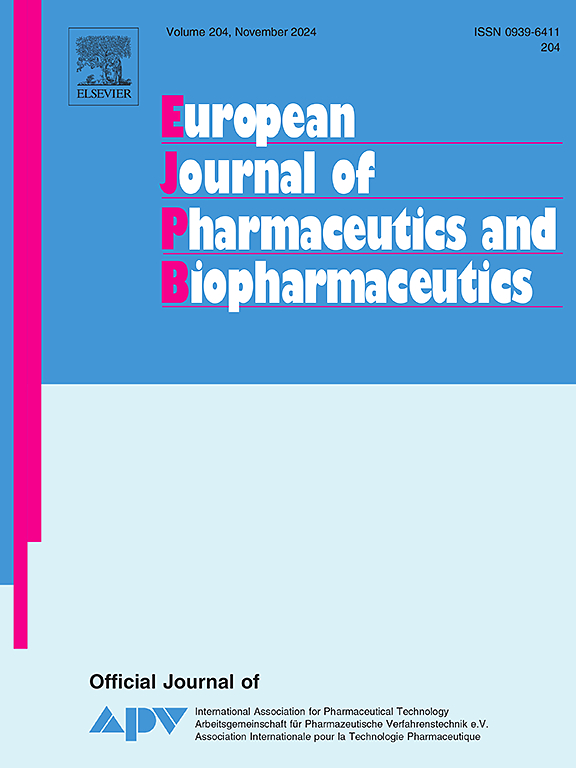Hydrophobic interactions enhance doxorubicin delivery from hyaluronic acid nanogels
IF 4.4
2区 医学
Q1 PHARMACOLOGY & PHARMACY
European Journal of Pharmaceutics and Biopharmaceutics
Pub Date : 2025-02-24
DOI:10.1016/j.ejpb.2025.114676
引用次数: 0
Abstract
This study introduces a novel targeted chemotherapy approach employing biocompatible nanogels engineered from hyaluronic acid (HA) and pitaya-derived DNA. Both polymers were functionalized with aldehyde groups, enabling crosslinking and subsequent encapsulation of doxorubicin (DOX). The incorporation of DNA significantly enhanced DOX loading, achieving a remarkable encapsulation efficiency of 93.3%. Notably, the integration of a hydrophobic 4,4′-dithiodianiline (DTD) linker facilitated controlled drug release within the reductive tumor microenvironment, with 36% of DOX released within 24 h in response to glutathione (GSH). These nanogels demonstrated targeted delivery to CD44-overexpressing cancer organoids, exhibiting a 6.7- to 15-fold increase in cellular uptake compared to free DOX. This enhanced intracellular DOX delivery significantly increased apoptosis in both cancer cells and organoids, as evidenced by increased condensed DNA and a 1.86- to 6.9-fold increase in poly ADP-ribose polymerase (PARP) expression. Importantly, hydrophobic interactions between the DTD linker and the cell membrane were found to significantly contribute to the efficient cellular uptake of the nanogels, resulting in a 2.6- to 9.1-fold reduction in IC50 values compared to free DOX. These findings highlight the potential of HA-based nanogels with cleavable linkers as promising platforms for targeted drug delivery and enhanced cancer therapy.

疏水相互作用增强阿霉素从透明质酸纳米凝胶的递送。
本研究介绍了一种新的靶向化疗方法,利用透明质酸(HA)和火龙果来源的DNA制成的生物相容性纳米凝胶。这两种聚合物都被醛基团功能化,从而实现交联和随后的阿霉素(DOX)包封。DNA的掺入显著提高了DOX的负载,达到了93.3%的包封效率。值得注意的是,疏水的4,4'-二硫代二苯胺(DTD)连接物的整合促进了还原性肿瘤微环境中药物的受控释放,36%的DOX响应谷胱甘肽(GSH)在24 h内释放。这些纳米凝胶显示靶向递送到cd44过表达的癌症类器官,与游离DOX相比,细胞摄取增加6.7至15倍。这种增强的细胞内DOX递送显著增加了癌细胞和类器官的凋亡,这可以通过浓缩DNA增加和聚adp核糖聚合酶(PARP)表达增加1.86- 6.9倍来证明。重要的是,发现DTD连接器和细胞膜之间的疏水相互作用显著有助于纳米凝胶的有效细胞摄取,导致IC50值比自由DOX降低2.6- 9.1倍。这些发现突出了具有可切割连接体的ha基纳米凝胶作为靶向药物递送和增强癌症治疗的有前途的平台的潜力。
本文章由计算机程序翻译,如有差异,请以英文原文为准。
求助全文
约1分钟内获得全文
求助全文
来源期刊
CiteScore
8.80
自引率
4.10%
发文量
211
审稿时长
36 days
期刊介绍:
The European Journal of Pharmaceutics and Biopharmaceutics provides a medium for the publication of novel, innovative and hypothesis-driven research from the areas of Pharmaceutics and Biopharmaceutics.
Topics covered include for example:
Design and development of drug delivery systems for pharmaceuticals and biopharmaceuticals (small molecules, proteins, nucleic acids)
Aspects of manufacturing process design
Biomedical aspects of drug product design
Strategies and formulations for controlled drug transport across biological barriers
Physicochemical aspects of drug product development
Novel excipients for drug product design
Drug delivery and controlled release systems for systemic and local applications
Nanomaterials for therapeutic and diagnostic purposes
Advanced therapy medicinal products
Medical devices supporting a distinct pharmacological effect.

 求助内容:
求助内容: 应助结果提醒方式:
应助结果提醒方式:


